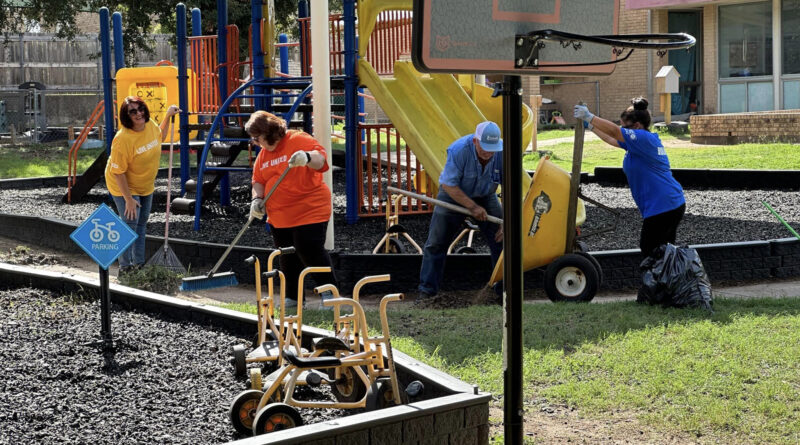How Nonprofit Organizations Make an Impact in a Community
By STEPHANIE O’BANION
 Nonprofit organizations play a valuable role in communities by providing critical services, convening stakeholders, driving solutions that improve lives and communities while also meeting the urgent needs of our neighbors during times of disaster and crisis. There are more than 130,000 nonprofit organizations in Texas, 23% of them in Central Texas. Each depends on the generosity of local communities, along with grant revenue opportunities, to survive, thrive and conduct their mission. I have seen firsthand the generosity of these communities when it comes to investing in local nonprofits to meet the needs of local families. This need is great and continues to grow. ALICE — an acronym for asset limited, income constrained, employed — represents a population who works but struggles to make ends meet every month. About 48% of Bell County households are within the ALICE threshold. There has never been a more crucial time for nonprofits and their work than now.
Nonprofit organizations play a valuable role in communities by providing critical services, convening stakeholders, driving solutions that improve lives and communities while also meeting the urgent needs of our neighbors during times of disaster and crisis. There are more than 130,000 nonprofit organizations in Texas, 23% of them in Central Texas. Each depends on the generosity of local communities, along with grant revenue opportunities, to survive, thrive and conduct their mission. I have seen firsthand the generosity of these communities when it comes to investing in local nonprofits to meet the needs of local families. This need is great and continues to grow. ALICE — an acronym for asset limited, income constrained, employed — represents a population who works but struggles to make ends meet every month. About 48% of Bell County households are within the ALICE threshold. There has never been a more crucial time for nonprofits and their work than now.
These nonprofit organizations can be both helpful and hurtful. One of the best books I have read regarding this topic is Toxic Charity by Robert D. Lupton. The book highlights how nonprofit organizations can unintentionally be harmful and perpetuate dependency and harm to recipients rather than empowering them to be successful. While most giving and serving is well-intentioned, it can also have negative consequences creating a dependency on aid rather than collaborating with the recipient to become self-reliant. Traditional charity models, where resources are simply given without considering long-term effects, leads to short-term fixes, feel-good giving and lack of accountability.
Effective giving focuses on approaches that empower individuals and communities to thrive independently while also addressing the root causes of these challenges.
There are nonprofit organizations in our community who practice effective, sustainable and empowering forms of giving. It is important to be well-informed and considerate of the true needs of the people and communities being served. Here are a few things to consider when looking to invest in a local nonprofit:
Mission and Purpose
- Examine the nonprofit’s mission and objectives. Does it have a clear, well-defined purpose that addresses a specific issue or need?
- Is the organization focused on providing long-term solutions or empowerment, or does it merely offer short-term solutions?
Transparency and Accountability
- Look for transparency in the nonprofit’s financial practices, including disclosure of financial statements, budgets and annual reports.
- Check is the organization is accountable for its actions and outcomes.
Effectiveness and Impact
- Look for the organization’s history in terms of the impact it has had in its area of service. What concrete results and outcomes can they demonstrate? Know that an outcome is different from an output. Knowing the number of individuals who have moved from food insecurity to food security is an outcome. Simply knowing how many pounds of food has been distributed is an output and does not demonstrate sustainable impact.
- Does the nonprofit use evidence-based practices and regularly evaluate program impact on the clients served? How do they gather data to demonstrate this?
Efficiency and Fiscal Responsibility
- Analyze how efficiently the nonprofit uses its resources. A good nonprofit should allocate a significant amount of its resources directly to its programs and services.
- Look at how much the organization spends on administrative and fundraising expenses. This is typically between 12% and 18% and is necessary for the organization to operate. The lower the percentage, the more efficient the organization is in utilizing donor funds.
Governance and Leadership
- Review the qualifications and experience of the nonprofit organization’s leadership and board members. Are they knowledgeable about the issues they are addressing?
Long-Term Sustainability
- Does the organization have a sustainability plan? Do they have diversified revenue streams or are they too dependent on donor gifts?
- How has the organization adapted to changing circumstances? A notable example is how the nonprofit pivoted during COVID-19.
Local Community Involvement
- A strong nonprofit engages and collaborates with the community it serves. It should seek input from beneficiaries and involve them in decision-making. When you empower and partner with beneficiaries together you create a sustainable future for all.
Ethics and Values
- Do their actions align with their stated values and principles?
- Consider any conflicts of interest or unethical practices.
Legal Compliance
- Not always the most exciting, but critical, the nonprofit’s legal status should be verified, including whether it adheres to relevant regulations and reporting requirements.
Volunteer and Employee Satisfaction
- If possible, gather feedback from volunteers, board members, and staff on the level of their satisfaction working with the organization.
- Research the nonprofit’s reputation. Reputable organizations will have a strong online and offline presence. Reviews are found through multiple online sources.
It is important to know that not all nonprofit organizations are inherently good or bad. It depends on the specific context and the organization’s practices. You can make a well-informed decision through a little research and asking questions to ensure the organization is effective and generates impact on the beneficiaries they serve and community.
Strong nonprofits also have a significant impact on the local economy. While the primary mission is to serve the public good rather than to generate profits, they also contribute to the local economy. Did you know Texas nonprofits:
- Support and contribute to every major industry in Texas?
- Hold more than $300 billion in assets?
- The majority operate with a budget of less than $1 million? (Many are less than $50,000 annually)
- Have a yearly growth rate of almost 10%, doubling the size of the sector in the last decade?
- Have diverse business models and rely on a mix of revenue sources?
- Provide 1:8 jobs across the state?
There are more than 130,000 nonprofits in Texas, which represents a growth of 22% between 2015 and 2022. These nonprofits represent 1.4 million employees and $110 billion toward the state’s GDP. Here are some of their economic impacts:
Job Creation: Nonprofits employ a substantial number of people in various roles, from program staff to administrative and support positions. These jobs provide income and contribute to employment levels.
Economic Activity: Nonprofits purchase goods and services from local businesses, such as office supplies, equipment and professional services. This contributes to local economic activity and supports other local businesses.
Volunteerism: Many nonprofits rely on volunteers to support their operations. This volunteer labor represents a significant contribution, as it saves the organization money that can be reinvested in its mission or operations. The current value for a volunteer hour in Texas is $31.63.
Tourism and Cultural Impact: Nonprofits that are in the arts, culture and heritage sectors attract visitors to the community, leading to increased tourism and related economic benefits.
Health and Social Services: Nonprofits providing health and social services help reduce the burden on public health systems and law enforcement, which can result in cost savings for local governments.
Community Development: Nonprofit community development organizations can stimulate local economic growth through initiatives like affordable housing, small business support and neighborhood revitalization.
Civic Engagement and Social Capital: Nonprofits can foster a sense of community and civic engagement, which can lead to improved quality of life and social cohesion, factors that indirectly impact the local economy.
Nonprofits are an integral part of the social fabric of a community. Their contributions extend beyond economic considerations to also include social, cultural and quality-of-life dimensions as well. Nonprofits enhance lives, meet needs and generate a positive impact on the local economy. When you invest in strong local nonprofits, you are not only impacting lives, but also economic outcomes for all.
Stephanie O’Banion is a certified nonprofit administrator. She has spent 30 years in the nonprofit sector. She currently serves as the president/CEO of the United Way of Central Texas. She is a board member of the United Way of Texas where she serves as the Advocacy and Policy Chair.




